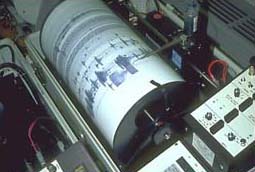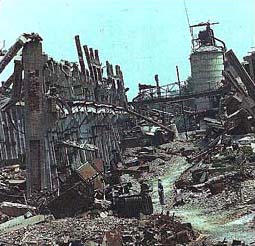Earthquakes
What is an earthquake?

The Earth's outer surface is broken into pieces called tectonic plates. These plates constantly move away from, towards or past each other. Because the continents are part of these plates, they also move. An earthquake occurs when the stresses caused by plate movements are released.
Most earthquakes occur on plate edges, especially where a plate is forced under another. Some regions have more earthquakes than others. In fact 80% of all recorded earthquakes occur around the edge of the Pacific Plate, including New Zealand, Papua New Guinea, Japan, Canada, USA and South America.
What causes earthquakes?

Earthquake occurs when plates grind and scrape against each other. For example in California there are 2 plates: the Pacific Plate and the North American Plate. The primary boundary between these 2 plates is the San Andreas fault.
A fault is a thin zone of crushed rock between two blocks of rock, and can be any length, from centimeters to thousands of kilometers. It is a fracture in the crust of the Earth along which rocks on one side have moved relative to those on the other side. Most faults are the result of repeated displacements over a long period of time.
Earthquakes occur on faults. When an earthquake occurs on one of these faults, the rock on one side of the fault slips with respect to the other. The fault surface can be vertical, horizontal, or at some angle to the surface of the Earth. The slip direction can also be at any angle.
Measuring earthquakes

Earthquakes are measured with a seismographic network. Each seismic station in the network measures the movement of the ground at the site. The slip of one block of rock over another in an earthquake releases energy that makes the ground vibrate. That vibration pushes the adjoining piece of ground and causes it to vibrate as well, and thus the energy travels out from the earthquake in a wave. Most earthquakes are measured by magnitude. Magnitude measures the energy produced by the earthquake, rather than what people feel during the event.
The instruments used to record the motion of the ground during earthquakes are called seismographs. First developed during the 1890's, these instruments are installed in the ground throughout the world and operate as seismographic network. At the heart of the seismograph is a seismometer, which is a pendulum or a mass mounted on a spring, and which moves during earthquakes.
The Deadliest earthquake

At 3:42 a.m. on July 28, 1976, a magnitude 7.8 earthquake hit the sleeping city of Tangshan, in North-eastern China. The very large earthquake, striking an area where it was totally unexpected, obliterated the city of Tangshan and killed over 240,000 people - making it the deadliest earthquake of the twentieth century.
When the 7.8 magnitude earthquake struck Tangshan at 3:42 a.m. on July 28, over a million people lay sleeping, unaware of the disaster that was to befall them. As the Earth began to shake, a few people who were awake had the forethought to dive under a table or other heavy piece of furniture, but most were asleep and did not have time. The entire earthquake lasted approximately 14 to 16 seconds.